JBL ProAquaTest Lab
Water tester
£101.00
(£79.53 / kg, Price shown includes 20% VAT.
Features & Advantages
- Simple and safe control of the water values in aquariums
- Determines pH value, carbonate hardness, total hardness, ammonium / ammonia, nitrite, nitrate, phosphate, iron, copper, silicate, oxygen and CO2
- Add reagents to water sample, compare with colour chart
- Natural water colouring is taken into account by the comparator system
- CO2 content is determined from the pH value and KH value in the table
- Childproof reagent bottles, waterproof plastic case
Looking for spare parts for this product?
Item no.: JBL-2408400, EAN: 4014162240842
Description
The JBL ProAqua Test Lab is a water test case with 13 water tests for the analysis of tap water and freshwater in aquariums.
Water is not simply water. Rainwater already absorbs pollutants and once it seeps into the groundwater, it is enriched with other substances that are not all suitable for the aquarium. Constant monitoring of the water values in the aquarium, especially when setting up a new one, is the top priority for successful aquaristics. With the ProAqua Test Lab, JBL enables you to quickly and precisely determine the 13 most important water values yourself in the home laboratory. Thanks to the enclosed, very detailed instructions for use with tips and advice, water testing is child's play. The contents of delivery include all required materials such as test reagents, dosing syringes, cuvettes, measuring spoons and colour cards. The test reagents can be purchased separately.
The following tests are included in the extensive water test case JBL ProAqua Test Lab:
JBL ProAqua Test KH
Depending on the origin, water, e.g.due to the nature of the substrate, contains different amounts of different mineral salts. A large part of the dissolved salts are alkaline earth and alkali hydrogen carbonates. Together with carbonates and carbon dioxide (CO2), hydrogen carbonates form an important buffer system that prevents dangerously high pH fluctuations in water. The measured carbonate hardness (KH) provides the total concentration of hydrogen carbonate in the water and can therefore in rare cases (if mainly alkali hydrogen carbonates are present, e.g. in East African lakes) be higher than the total hardness, which only takes account of alkaline earth salts. Most freshwater fish and plants in the aquarium can be successfully maintained with a carbonate hardness of around 5-16 ° dH. For optimal CO2 fertilisation, however, the carbonate hardness should not be below 5 ° dH. If there is a lack of CO2, aquatic plants or, above all, algae consume hydrogen carbonate (biogenic decalcification) due to their rapid assimilation during photosynthesis and can thus dangerously raise the pH value for fish (over 10).
JBL ProAqua Test GH
Depending on the origin of the water, e.g. due to the nature of the substrate contain different amounts of mineral salts. By definition, the total hardness is the total concentration of all alkaline earth ions in the water. The total hardness is largely formed by calcium and magnesium salts. Most fish and plants can be successfully maintained with a total hardness of 5-25 ° dH.
JBL ProAqua Test pH 3-10 / pH 6.0-7.6 / pH 7.4-9.0
Maintaining a suitable pH value as constant as possible is an important prerequisite for the well-being of all aquatic organisms. Above all, sudden fluctuations should be avoided. In addition, many substances dissolved in water are subject to changes depending on the pH. For example, the amount of CO2 that can be dissolved in water is directly related to the pH value. The pH value can, therefore, serve as a simple control variable for setting CO2 fertiliser systems, as long as there are no other acids (e.g. humic acids) in the water that influence the pH value. The optimal CO2 concentration for plants and harmless for fish is achieved at a pH of around 6.8-7.3. The carbonate hardness should not be below 4 ° dH. An exact pH measurement also for special applications such as B. fish farming, may be required. JBL PRO AQUATEST pH 6.0-7.6 is also used here. The optimum pH value for keeping most freshwater fish and plants is in the neutral range around 7. However, there are also freshwater fish that need slightly acidic or alkaline water. For particularly precise measurements of the pH value, there is the JBL PRO AQUATEST pH 6.0-7.6 (also for checking the CO2 fertilisation) for freshwater aquariums and the JBL PRO AQUATEST pH 7.4 for freshwater aquariums -9.0. For seawater organisms, pH values around 8.2 can be regarded as optimal. Especially in saltwater aquariums with lower animals (invertebrates), the consumption of calcium bicarbonate can cause the pH value (and the carbonate hardness) to drop if a supply is not made regularly. When caring for fish from slightly alkaline freshwater, such as for example, Lake Malawi and Lake Tanganyika, values around 8-8.5 are recommended. For Koi and others, pH values between 7.5-8.5 can be regarded as optimal. In the garden pond, but especially in the aquarium, if there is a lack of CO2, especially algae, due to their rapid assimilation during photosynthesis, can consume the hydrogen carbonate in the water (biogenic decalcification) and thus drive the pH value to dangerous levels for fish (over 10).
JBL PRO AQUATEST NH4
The degradation of all organic substances (feed and plant residues, fish excretions) in the aquarium and pond takes place via the so-called nitrogen cycle. Proteins in ammonium are transformed into nitrite and harmless nitrate. Certain bacteria are responsible for this process. By measuring the individual intermediate stages ammonium, nitrite and nitrate, statements can be made about the "functioning" of the system. For example, medicines to cure fish diseases can damage the beneficial cleaning bacteria and thus lead to an increase in the ammonium and / or nitrite content. As a rule, ammonium will not be measurable in a well-maintained aquarium with a powerful biological filter. Ammonium is a plant nutrient and is non-toxic to fish in low concentrations. Depending on the pH, however, ammonium can produce toxic ammonia (NH3). For this reason, a pH measurement should always be carried out with the ammonium measurement.
JBL PRO AQUATEST NO2
Like ammonia, nitrite is a strong fish poison. Depending on the sensitivity of the fish species, concentrations between 0.5 and 1 mg / l (ppm) can be fatal. Seawater fish and young fish are more sensitive than adults.
JBL PRO AQUATEST NO3
Ammonium and nitrite should not normally accumulate, but if they do, there may be a disturbance in the bacterial balance. A continuously increasing nitrate content with a low to undetectable ammonium and nitrite content shows a well-functioning bacterial balance, but at the same time indicates an insufficient balance between fish (nitrogen source) and plants (consumers). Excessive nitrate levels promote undesirable algae growth if, in addition to nitrite, phosphate is also available in the water. The nitrate content should therefore not exceed 30 mg / l in freshwater and 20 mg / l in seawater. The opposite can happen in heavily planted aquariums with just a few small fish: nitrate becomes a deficiency factor and must be replenished in order for the plants to thrive optimally.
JBL PRO AQUATEST PO4 sensitive
Phosphate is an important plant nutrient. In natural waters without pollution, the phosphate concentration is around 0.01 mg / l and 0.07 mg / l in sea water. Plants and algae have adapted to this scarce phosphate supply and can therefore make do with small amounts. Phosphate enters the water mainly through the digestive processes of fish and food residues. Especially with a strong fish stock, phosphate levels can be reached, which are sometimes 100 times higher than the natural values. Some waterworks also add phosphates to the tap water to prevent limescale and corrosion in the power system. As a result of the unnaturally high supply of nutrients, algae multiply explosively. Algae can store phosphate in significant quantities and thus continue to grow unabated even after the phosphate content has been reduced. The sooner the rising phosphate content is recognised, the more likely an algae plague can be averted. The opposite can occur in heavily planted aquariums with just a few fish: phosphate becomes a deficiency factor and must be dosed in order for the plants to thrive optimally. This is especially the case with aquascaping. The phosphate content should remain below 0.4 mg / l in freshwater aquariums and below 0.1 mg / l in saltwater aquariums.
JBL PRO AQUATEST SiO2
Silicon is one of the most common elements on earth. When silicate rock is weathered, silicon gets into surface and groundwater in the form of silicates. There it serves as a nutrient for diatoms, some aquatic plants (e.g. hornwort) and pebble sponges. Since silicates are non-toxic, there are no limits in the drinking water ordinance. Depending on the region, service water, therefore, contains high levels of dissolved silicate. After aquariums have been newly set up, brown deposits from diatoms are often the first to settle. These deposits slowly disappear when there is sufficient competition from other algae and microorganisms. The silicate content in the water is also reduced. Often, however, such diatom deposits can reappear after changing the water and the newly added silicate, especially in seawater. Therefore, silicate-free osmosis water should preferably be used for filling and changing water in saltwater aquariums. The silicate content should be below 1.2 mg / l in freshwater and below 0.4 mg / l in seawater.
JBL PRO AQUATEST Fe
Iron is an essential trace element for plant and animal organisms. In addition to an adequate supply of CO2 and other trace elements, iron is crucial for good plant growth and is continuously consumed. Glassy-yellowish colouring in young leaf shoots and younger leaves is a sign of iron deficiency. Iron and some other trace elements are only stable in water for a limited time, even if they are bound to so-called chelators, as is common in modern fertiliser preparations. In addition, tap water supplied is usually iron-free. Therefore, the iron content must be monitored by a regular check with this test and if necessary re-fertilised. A concentration of 0.1-0.2 mg / l is sufficient for good plant growth. For very densely planted aquariums, values up to 0.6 mg / l can also be useful. Values of up to 0.05 mg / l are recommended in seawater.
JBL PRO AQUATEST CU
Copper is a heavy metal that is indispensable as a trace element on the one hand, and on the other hand has a devastating effect as a cell poison from a certain concentration. Copper reaches the aquarium primarily via tap water, since copper pipes were often used for water installation. If the water remains in such pipes for a long time, considerable amounts of copper can dissolve. The water in the pipe should, therefore, be drained off before use. For the same reason, rainwater that has flowed over copper gutters should also be avoided. Also when installing aquariums or ponds, make sure that copper-free metal objects are used. Controlled copper entry occurs through the use of medication for parasitic diseases in fish, as well as some algae killers. The copper concentrations targeted there can be tolerated by fish for a certain time, whereas parasites die off.
JBL PRO AQUATEST O2
All animals living in the water need oxygen to breathe. The “invisible helpers” in the aquarium and pond, the cleaning bacteria, also need sufficient oxygen to convert ammonium to nitrate. The necessary oxygen supply can be ensured by sufficient planting. In aquariums and ponds with little or no planting and in seawater aquariums, the oxygen content should always be kept at the appropriate saturation level by technical equipment. The saturation value depends on water temperature. Plants are able to exceed this saturation level through assimilation. In well-planted aquariums and ponds, values can be found towards the end of the lighting period that are 1-2 mg / l above the saturation value.
Our expert Oliver Knott recommends:
To ensure that everything runs smoothly in the aquarium, the water test case from JBL should not be missing in the aquarium household. This is the only way to react quickly enough if water parameters are suddenly “out of control”.
| Brands (Manufacturers): | JBL |
|---|---|
| Usage: | Aquarium, Saltwater, Fresh water |
| Usage of Measuring Devices & Water Tests: | Iron, Carbonate hardness, Nitrate, Nitrite, Phosphate, pH value, Silicate, Water hardness |
| Manufacturer: | JBL GmbH & Co. KG, Dieselstrasse 3, 67414, Neuhofen, Germany, www.JBL.de |
Hazard and precautionary statements
Signal word: Warning
Precautionary statements:
- P101 - If medical advice is needed, have product container or label at hand.
- P102 - Keep out of reach of children.
- P303+P361+P353 - IF ON SKIN (or hair): Take off immediately all contaminated clothing. Rinse skin with water [or shower].
- P305+P351+P338 - IF IN EYES: Rinse cautiously with water for several minutes. Remove contact lenses, if present and easy to do. Continue rinsing.
- P501 - Dispose of contents/container according to local/national regulations.
Hazard statements:
- H226 - Flammable liquid and vapour
- H319 - Causes serious eye irritation
Signal word: Danger
Precautionary statements:
- P101 - If medical advice is needed, have product container or label at hand.
- P102 - Keep out of reach of children.
- P303+P361+P353 - IF ON SKIN (or hair): Take off immediately all contaminated clothing. Rinse skin with water [or shower].
- P305+P351+P338 - IF IN EYES: Rinse cautiously with water for several minutes. Remove contact lenses, if present and easy to do. Continue rinsing.
- P501 - Dispose of contents/container according to local/national regulations.
Hazard statements:
- H314 - Causes severe skin burns and eye damage.
- H290 - May be corrosive to metals
- H318 - Causes serious eye damage.
Signal word: Danger
Precautionary statements:
- P101 - If medical advice is needed, have product container or label at hand.
- P102 - Keep out of reach of children.
- P303+P361+P353 - IF ON SKIN (or hair): Take off immediately all contaminated clothing. Rinse skin with water [or shower].
- P305+P351+P338 - IF IN EYES: Rinse cautiously with water for several minutes. Remove contact lenses, if present and easy to do. Continue rinsing.
- P501 - Dispose of contents/container according to local/national regulations.
Hazard statements:
- H314 - Causes severe skin burns and eye damage.
- H411 - Toxic to aquatic life with long lasting effects
- H317 - May cause an allergic skin reaction
- H315 - Causes skin irritation
- H319 - Causes serious eye irritation
- H400 - Very toxic to aquatic life
- H410 - Very toxic to aquatic life with long lasting effects
Signal word: Danger
Precautionary statements:
- P101 - If medical advice is needed, have product container or label at hand.
- P102 - Keep out of reach of children.
- P303+P361+P353 - IF ON SKIN (or hair): Take off immediately all contaminated clothing. Rinse skin with water [or shower].
- P305+P351+P338 - IF IN EYES: Rinse cautiously with water for several minutes. Remove contact lenses, if present and easy to do. Continue rinsing.
- P501 - Dispose of contents/container according to local/national regulations.
Hazard statements:
- H301 - Toxic if swallowed
- H311 - Toxic in contact with skin
- H314 - Causes severe skin burns and eye damage.
- H317 - May cause an allergic skin reaction
- H319 - Causes serious eye irritation
- H331 - Toxic if inhaled
- H335 - May cause respiratory irritation
- Suspected of causing genetic defects.
- H400 - Very toxic to aquatic life
- H410 - Very toxic to aquatic life with long lasting effects
- H412 - Harmful to aquatic life with long lasting effects
Signal word: Warning
Precautionary statements:
- P101 - If medical advice is needed, have product container or label at hand.
- P102 - Keep out of reach of children.
- P303+P361+P353 - IF ON SKIN (or hair): Take off immediately all contaminated clothing. Rinse skin with water [or shower].
- P305+P351+P338 - IF IN EYES: Rinse cautiously with water for several minutes. Remove contact lenses, if present and easy to do. Continue rinsing.
- P501 - Dispose of contents/container according to local/national regulations.
Hazard statements:
- H302 - Harmful if swallowed
- H317 - May cause an allergic skin reaction
- H290 - May be corrosive to metals
- H301 - Toxic if swallowed
Hazard statements:
- H315 - Causes skin irritation
- H319 - Causes serious eye irritation
- H335 - May cause respiratory irritation
Signal word: Warning
Precautionary statements:
- P101 - If medical advice is needed, have product container or label at hand.
- P102 - Keep out of reach of children.
- P303+P361+P353 - IF ON SKIN (or hair): Take off immediately all contaminated clothing. Rinse skin with water [or shower].
- P305+P351+P338 - IF IN EYES: Rinse cautiously with water for several minutes. Remove contact lenses, if present and easy to do. Continue rinsing.
- P501 - Dispose of contents/container according to local/national regulations.
Hazard statements:
- H226 - Flammable liquid and vapour
- H319 - Causes serious eye irritation
- H225 - Highly flammable liquid and vapour
Signal word: Danger
Precautionary statements:
- P101 - If medical advice is needed, have product container or label at hand.
- P102 - Keep out of reach of children.
- P303+P361+P353 - IF ON SKIN (or hair): Take off immediately all contaminated clothing. Rinse skin with water [or shower].
- P305+P351+P338 - IF IN EYES: Rinse cautiously with water for several minutes. Remove contact lenses, if present and easy to do. Continue rinsing.
- P501 - Dispose of contents/container according to local/national regulations.
Hazard statements:
- H314 - Causes severe skin burns and eye damage.
- H290 - May be corrosive to metals
- H318 - Causes serious eye damage.
Signal word: Danger
Precautionary statements:
- P101 - If medical advice is needed, have product container or label at hand.
- P102 - Keep out of reach of children.
- P303+P361+P353 - IF ON SKIN (or hair): Take off immediately all contaminated clothing. Rinse skin with water [or shower].
- P305+P351+P338 - IF IN EYES: Rinse cautiously with water for several minutes. Remove contact lenses, if present and easy to do. Continue rinsing.
- P501 - Dispose of contents/container according to local/national regulations.
Hazard statements:
- H314 - Causes severe skin burns and eye damage.
- H412 - Harmful to aquatic life with long lasting effects
- H290 - May be corrosive to metals
- H302 - Harmful if swallowed
- H400 - Very toxic to aquatic life
- H411 - Toxic to aquatic life with long lasting effects
- EUH 031 - Contact with acids liberates toxic gas.
Signal word: Danger
Precautionary statements:
- P101 - If medical advice is needed, have product container or label at hand.
- P102 - Keep out of reach of children.
- P303+P361+P353 - IF ON SKIN (or hair): Take off immediately all contaminated clothing. Rinse skin with water [or shower].
- P305+P351+P338 - IF IN EYES: Rinse cautiously with water for several minutes. Remove contact lenses, if present and easy to do. Continue rinsing.
- P501 - Dispose of contents/container according to local/national regulations.
Hazard statements:
- H314 - Causes severe skin burns and eye damage.
- H300 - Fatal if swallowed
- H302 - Harmful if swallowed
- H310 - Fatal in contact with skin
- H400 - Very toxic to aquatic life
- H410 - Very toxic to aquatic life with long lasting effects
Signal word: Danger
Precautionary statements:
- P101 - If medical advice is needed, have product container or label at hand.
- P102 - Keep out of reach of children.
- P303+P361+P353 - IF ON SKIN (or hair): Take off immediately all contaminated clothing. Rinse skin with water [or shower].
- P305+P351+P338 - IF IN EYES: Rinse cautiously with water for several minutes. Remove contact lenses, if present and easy to do. Continue rinsing.
- P501 - Dispose of contents/container according to local/national regulations.
Hazard statements:
- May cause damage to organs through prolonged or repeated exposure.
- H314 - Causes severe skin burns and eye damage.
- H412 - Harmful to aquatic life with long lasting effects
Signal word: Warning
Precautionary statements:
- P101 - If medical advice is needed, have product container or label at hand.
- P102 - Keep out of reach of children.
- P303+P361+P353 - IF ON SKIN (or hair): Take off immediately all contaminated clothing. Rinse skin with water [or shower].
- P305+P351+P338 - IF IN EYES: Rinse cautiously with water for several minutes. Remove contact lenses, if present and easy to do. Continue rinsing.
- P501 - Dispose of contents/container according to local/national regulations.
Hazard statements:
- H226 - Flammable liquid and vapour
- H319 - Causes serious eye irritation
- H225 - Highly flammable liquid and vapour
Signal word: Warning
Precautionary statements:
- P101 - If medical advice is needed, have product container or label at hand.
- P102 - Keep out of reach of children.
- P303+P361+P353 - IF ON SKIN (or hair): Take off immediately all contaminated clothing. Rinse skin with water [or shower].
- P305+P351+P338 - IF IN EYES: Rinse cautiously with water for several minutes. Remove contact lenses, if present and easy to do. Continue rinsing.
- P501 - Dispose of contents/container according to local/national regulations.
Hazard statements:
- H226 - Flammable liquid and vapour
- H319 - Causes serious eye irritation
Signal word: Warning
Precautionary statements:
- P101 - If medical advice is needed, have product container or label at hand.
- P102 - Keep out of reach of children.
- P303+P361+P353 - IF ON SKIN (or hair): Take off immediately all contaminated clothing. Rinse skin with water [or shower].
- P305+P351+P338 - IF IN EYES: Rinse cautiously with water for several minutes. Remove contact lenses, if present and easy to do. Continue rinsing.
- P501 - Dispose of contents/container according to local/national regulations.
Hazard statements:
- H226 - Flammable liquid and vapour
- H319 - Causes serious eye irritation
Signal word: Warning
Precautionary statements:
- P101 - If medical advice is needed, have product container or label at hand.
- P102 - Keep out of reach of children.
- P303+P361+P353 - IF ON SKIN (or hair): Take off immediately all contaminated clothing. Rinse skin with water [or shower].
- P305+P351+P338 - IF IN EYES: Rinse cautiously with water for several minutes. Remove contact lenses, if present and easy to do. Continue rinsing.
- P501 - Dispose of contents/container according to local/national regulations.
Hazard statements:
- H226 - Flammable liquid and vapour
- H315 - Causes skin irritation
- H319 - Causes serious eye irritation
- H225 - Highly flammable liquid and vapour
- H302 - Harmful if swallowed
- H314 - Causes severe skin burns and eye damage.
- H332 - Harmful if inhaled
- H335 - May cause respiratory irritation
- May cause damage to organs through prolonged or repeated exposure.
- H400 - Very toxic to aquatic life
- H411 - Toxic to aquatic life with long lasting effects
Signal word: Danger
Precautionary statements:
- P101 - If medical advice is needed, have product container or label at hand.
- P102 - Keep out of reach of children.
- P303+P361+P353 - IF ON SKIN (or hair): Take off immediately all contaminated clothing. Rinse skin with water [or shower].
- P305+P351+P338 - IF IN EYES: Rinse cautiously with water for several minutes. Remove contact lenses, if present and easy to do. Continue rinsing.
- P501 - Dispose of contents/container according to local/national regulations.
Hazard statements:
- H314 - Causes severe skin burns and eye damage.
- H290 - May be corrosive to metals
- H318 - Causes serious eye damage.
Signal word: Danger
Precautionary statements:
- P101 - If medical advice is needed, have product container or label at hand.
- P102 - Keep out of reach of children.
- P303+P361+P353 - IF ON SKIN (or hair): Take off immediately all contaminated clothing. Rinse skin with water [or shower].
- P305+P351+P338 - IF IN EYES: Rinse cautiously with water for several minutes. Remove contact lenses, if present and easy to do. Continue rinsing.
- P501 - Dispose of contents/container according to local/national regulations.
Hazard statements:
- H314 - Causes severe skin burns and eye damage.
- H225 - Highly flammable liquid and vapour
- H319 - Causes serious eye irritation
Signal word: Danger
Precautionary statements:
- P101 - If medical advice is needed, have product container or label at hand.
- P102 - Keep out of reach of children.
- P303+P361+P353 - IF ON SKIN (or hair): Take off immediately all contaminated clothing. Rinse skin with water [or shower].
- P305+P351+P338 - IF IN EYES: Rinse cautiously with water for several minutes. Remove contact lenses, if present and easy to do. Continue rinsing.
- P501 - Dispose of contents/container according to local/national regulations.
Hazard statements:
- H226 - Flammable liquid and vapour
- H314 - Causes severe skin burns and eye damage.
- H319 - Causes serious eye irritation
- H225 - Highly flammable liquid and vapour
Signal word: Danger
Precautionary statements:
- P101 - If medical advice is needed, have product container or label at hand.
- P102 - Keep out of reach of children.
- P303+P361+P353 - IF ON SKIN (or hair): Take off immediately all contaminated clothing. Rinse skin with water [or shower].
- P305+P351+P338 - IF IN EYES: Rinse cautiously with water for several minutes. Remove contact lenses, if present and easy to do. Continue rinsing.
- P501 - Dispose of contents/container according to local/national regulations.
Hazard statements:
- H225 - Highly flammable liquid and vapour
- H315 - Causes skin irritation
- H319 - Causes serious eye irritation
- H336 - May cause drowsiness or dizziness
- H300 - Fatal if swallowed
- H302 - Harmful if swallowed
- H314 - Causes severe skin burns and eye damage.
- H411 - Toxic to aquatic life with long lasting effects
Signal word: Danger
Precautionary statements:
- P101 - If medical advice is needed, have product container or label at hand.
- P102 - Keep out of reach of children.
- P303+P361+P353 - IF ON SKIN (or hair): Take off immediately all contaminated clothing. Rinse skin with water [or shower].
- P305+P351+P338 - IF IN EYES: Rinse cautiously with water for several minutes. Remove contact lenses, if present and easy to do. Continue rinsing.
- P501 - Dispose of contents/container according to local/national regulations.
Hazard statements:
- H314 - Causes severe skin burns and eye damage.
- H226 - Flammable liquid and vapour
- H335 - May cause respiratory irritation
Downloads
Related products
Similar products
Customer Reviews
1 English review written for JBL ProAquaTest Lab
24 customer reviews in all languages
| 5 stars | | 36 | (87%) |
|---|---|---|---|
| 4 stars | | 3 | (7%) |
| 3 stars | | 1 | (2%) |
| 2 stars | | 0 | (0%) |
| 1 Stars | | 1 | (2%) |
41 reviews
1 customer review in English
24 customer reviews in all languages
Magazine Articles:
Discover Olibetta:
-
Great Britain: Free standard delivery from £69.90
-
Free
returns -
We operate in a
climate-conscious manner. Secure payments
with SSL encryption technology
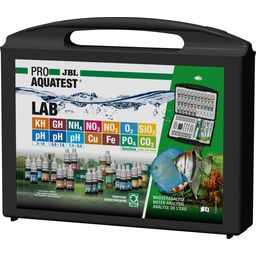
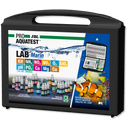
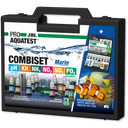
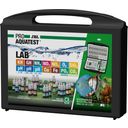

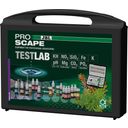
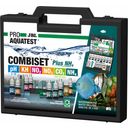
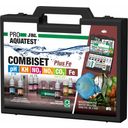
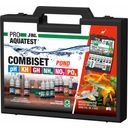
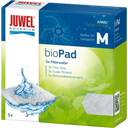





djr
Rated with 5 out of 5 stars.
Previously used Proscan due to colour blindness issues. Eventually bought this and found some of the Proscan readings were not very accurate- some were fine others way off.
Even with my colour problems I have found so far I have no problems with these colour charts - not the case with some very popular other manufacturers.
Tests are very easy to do. Download the instructions to your phone/ipad and highlight the relevant parts in your language makes it so much easier.
Was this rating helpful? (0) (0)